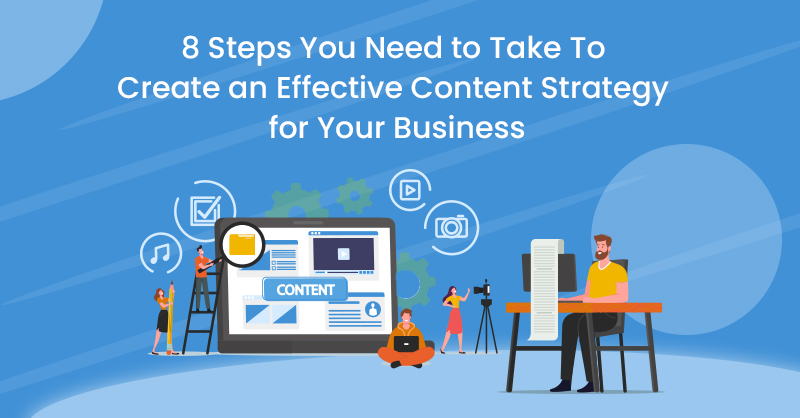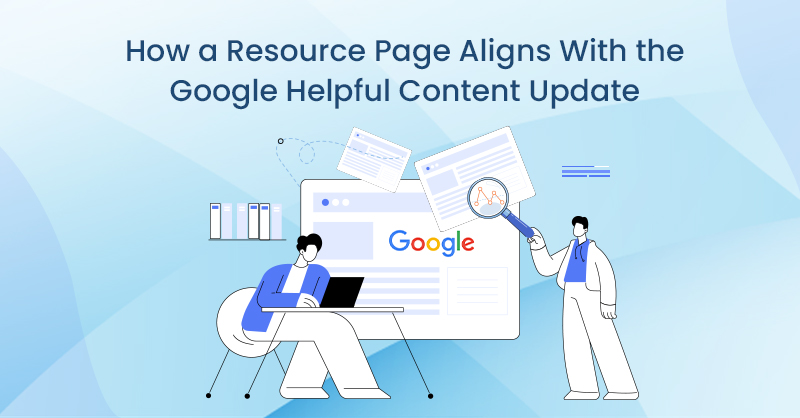The days of making content for the sake of content creation are long gone. Today’s consumers (and search engines) are much more thoughtful when it comes to the types of content they consume and consider good quality.
Whether you have an existing content marketing strategy, or you’re starting from scratch—taking the time to sit down and map out a content plan can make all the difference when it comes to building brand awareness and loyalty, achieving better search engine rankings, and increasing traffic and conversions on your website.
In this article, we’ll cover everything you need to know about content marketing strategies and provide you with a list of eight important steps you need to take in order to create an effective content strategy for your business.
What Exactly Is Content Strategy?
If you’re a small to medium-sized business, the thought of coming up with a content strategy may seem daunting and time-consuming—but it doesn’t need to be!
Simply put, a content strategy is a plan that you create that outlines content topics, formats, and a general timeline that you will use to publish your content. This plan should align with both your brand/business goals and your target audience’s customer journey.
Creating content with a clear purpose and goal in mind will not only help you save time and money, but it will also show your audience that you care about them and have their best interests in mind.
Other benefits of having a good content strategy include an increase in brand awareness and authority, figuring out how it can work alongside your SEO strategy (which helps with lead generation and website traffic) , and building trust with your audience (which will help increase your conversion rate).
At the end of the day, taking the time to create an effective content strategy can help your business stand out from the competition. In the following sections, we’ll cover further advantages of having a content marketing strategy, as well as the eight essential steps you need to take to build an effective content strategy. Let's dive in!

The Advantages of a Content Marketing Strategy
As mentioned above, there are many advantages to having a good content strategy. While you may not see the immediate results of making these changes, the long-term benefits are undeniable. Let’s take a closer look at how a content marketing strategy can help your business.
1. Enriches your brand loyalty.
Building brand loyalty and authority is the key to keeping customers and qualified leads coming back to your website. How do you achieve this with a content marketing strategy? You create content that is informative, valuable, and engaging for your audience. In 2023, successful content marketing strategies are sure to include personalization, as it’s a proven way to connect with your audience and build brand loyalty.
2. Allows you to remarket to a wider audience.
Utilizing remarketing tactics in your content marketing strategy is a surefire way to capture leads and keep them. If a lead has already shown interest in your content, then you’re halfway there. When creating your content plan, remarketing can include strategies such as email campaigns, social media posts, etc. Another aspect of content remarketing could also be current users sharing your brand/business’s content. The more valuable they deem your content, the more likely they will be to share it which allows you to reach a wider audience at a low cost.
3. Enhances Search Engine visibility.
Investing in high-quality SEO content will help enhance your search engine visibility. Aligning your SEO and content marketing strategies is essential to achieving the results you want, and ranking higher on the SERPs. Good quality content combined with long-tail keywords means that search engines like Google have more to crawl and index. Whether it’s landing pages, blogs, or product and service descriptions - as long as they’re optimized for SEO and provide your consumer with valuable information, then you’re on the right track!
4. Helps your business achieve a higher domain authority.
As mentioned above, if a search engine recognizes your website as valuable, educational, and accurate, you’ll achieve a higher domain authority. Additionally, earning high-quality inbound links from credible sources to your website will also increase your domain authority and boost your organic ranking.
5. Increases the likelihood of conversions.
The primary goal of your content should always be to engage, bring value, and educate your audience. If you have experience in Content or Social Media marketing, then you’ve likely heard of the 80/20 rule. This rule is a formula for your content strategy, meaning that 80% of your content should be non-promotional, and the remaining 20% can be centered around products and services. Customers want to know why they should support your brand, and storytelling is a great way to connect with your audience (80%). Once your customer sees the value in your brand, then you’re more likely to convince them of how your products and services will benefit them (20%); effectively increasing the likelihood of conversion.

8 Important Steps for Developing an Effective Content Strategy
Now that we’ve covered all the advantages, it’s time to review some steps you need to take to develop a content strategy (that actually works). Here are the essential steps you’ll need to take to get started:
1. Determine your goals and objectives.
The very first step you need to take is to figure out what you’re looking to achieve with your content strategy. Coming up with a SMART plan will help you create realistic business goals that also align with the needs of your audience.
2. Analyze your audience.
The next step to creating an effective content strategy is to analyze and understand your audience (especially if you’re starting from scratch). Taking the time to sit down and create a buyer persona will help you understand the type of content your audience will find interesting, helpful, and engaging. It will also help you determine at what point throughout the customer journey certain content should be presented to them.
3. Perform a content audit.
Whether you’re a new business, or you’ve been around for a while, performing a content audit should be a part of your content strategy. There is no point wasting your valuable time putting effort into content that is underperforming. This is why taking a step back every once in a while will allow you to gain perspective on what content pieces are doing well and what you should consider moving away from.
4. Get ideas for content using various tools.
Let’s face it, coming up with content can be a lot more difficult than some of us care to admit. Especially if you’ve been doing it for a while—the content block can be real! Luckily, in 2023 there are plenty of resources you can draw from if you’re lacking inspiration, such as HubSpot’s blog topic generator, Answer the Public, and SEMrush’s Topic Research Tool, to name a few! If all else fails, the FAQ section on Google’s SERP is also a solid option.
5. Organize and plan your content.
Now that you’ve set up your goals, analyzed your audience, performed a content audit, and gathered some fresh content ideas, it’s time to organize and plan your future content. Creating content pillars for your business and brand will help you stay organized, remain on track, and be a reference point for each member of your content team.
6. Create your content.
Phew! Okay, now we’re ready to actually start making the content! Whether it’s blogs, videos, social media, email copy, etc. as long as it’s in line with your goals, relevant, and helpful for your customers then we’re sure they’ll love it! Make sure you allow yourself enough time to make edits or even to redo pieces. Good content takes time and has multiple drafts!
7. Schedule your content.
Choosing a content scheduling tool is another great way to stay organized and make sure your content is being published exactly when you need it to be.
8. Analyze your results and listen to your audience.
Again, performing regular content audits and analyzing your results is what’s going to be the driving force behind creating a content strategy that actually works! While organic content may take a bit longer to show results, it will be one of the biggest indicators of the effectiveness of your content strategy. Finally, no one can help you more at the end of the day than your audience can. Take some time to practice some good old social listening and discover more of what excites and engages your audience.
Wrap up
In this article, we covered all the tips and tricks you’ll need to create an effective content marketing strategy. From building brand awareness and loyalty, achieving better search engine rankings, and increasing traffic and conversions on your website—there’s no denying the difference that having a good content strategy can make for your business.
We hope that you have a better understanding of how to either get started or re-vamp your current strategy. However, if you’re still feeling a bit lost that’s totally understandable! That’s why we’re here to help. Our content marketing experts will work with you to build a content strategy that is built for people, and optimized for search engines.
If you need help with devising the perfect content marketing strategy, Techwyse is here to help! We specialize in a wide range of digital marketing services in Toronto, including strategy and consulting, creative design, traffic building, and so much more. To book an appointment, call 866-208-3095 or contact us here.
FAQs
-
Is it essential to create a content marketing plan for my business?
Yes! Creating a content strategy is a fundamental step in helping you achieve your business goals, grow your brand awareness and authority, and rank higher than your competition.
-
How frequently should I update my content strategy?
This ultimately depends on your SMART goals and reviewing your results, but it’s recommended you revisit or refresh your content strategy bi-annually or annually at the very minimum.
-
Which are the crucial elements included in the content marketing strategy?
The crucial elements of a content marketing strategy include determining your goals and objectives, analyzing your audience and creating buyer personas, creating content pillars to organize and keep track of your content, and finally analyzing and auditing your content.






on
To maximize its marketing potential, blogging should be utilized in conjunction with other strategies. Repurposing your blogs into social media material is a fantastic idea in addition to search engine optimization. Promoting your blog across social media platforms not only increases website traffic and brand visibility, but also provides a wealth of material for use in other social media posts.